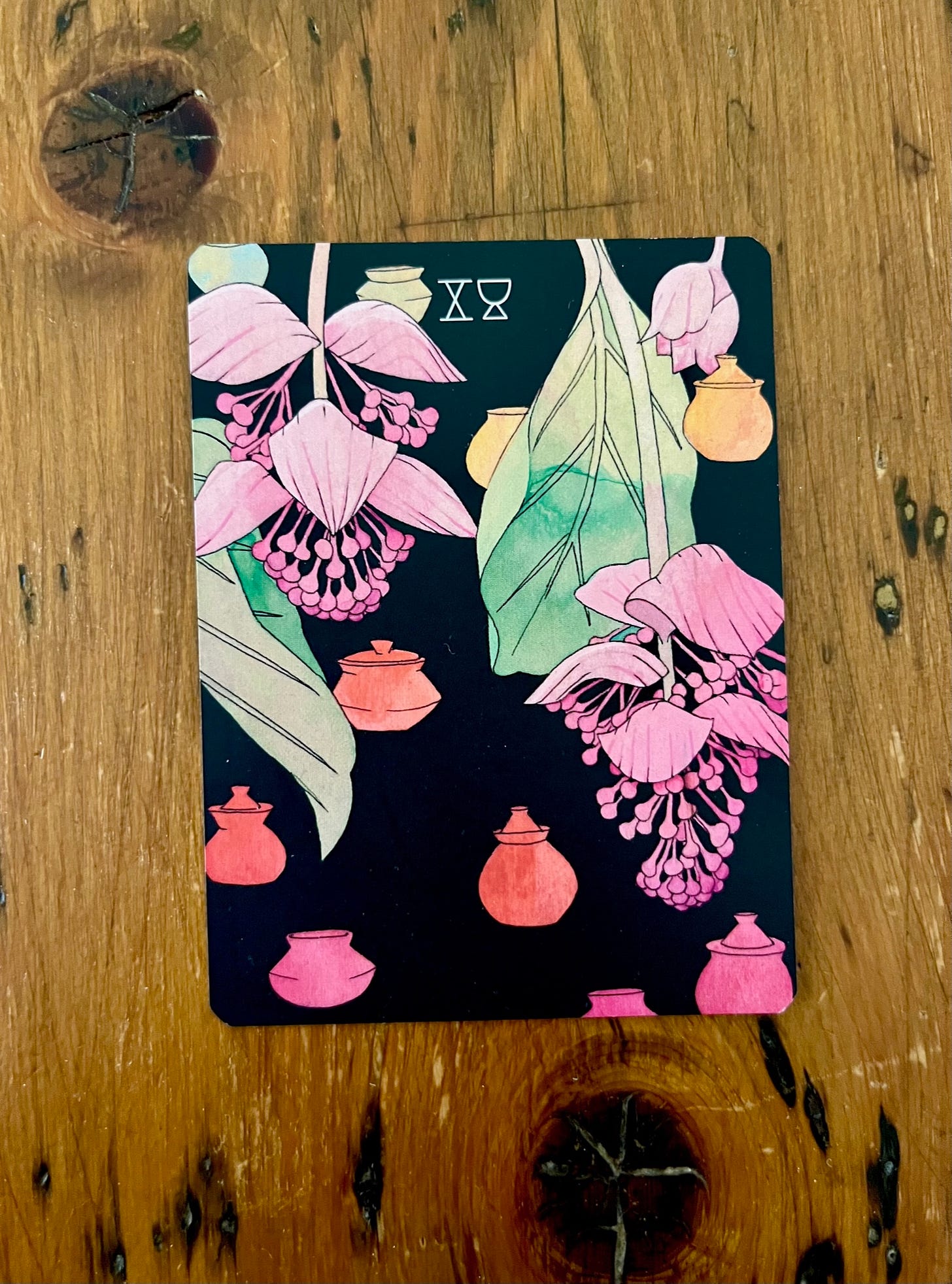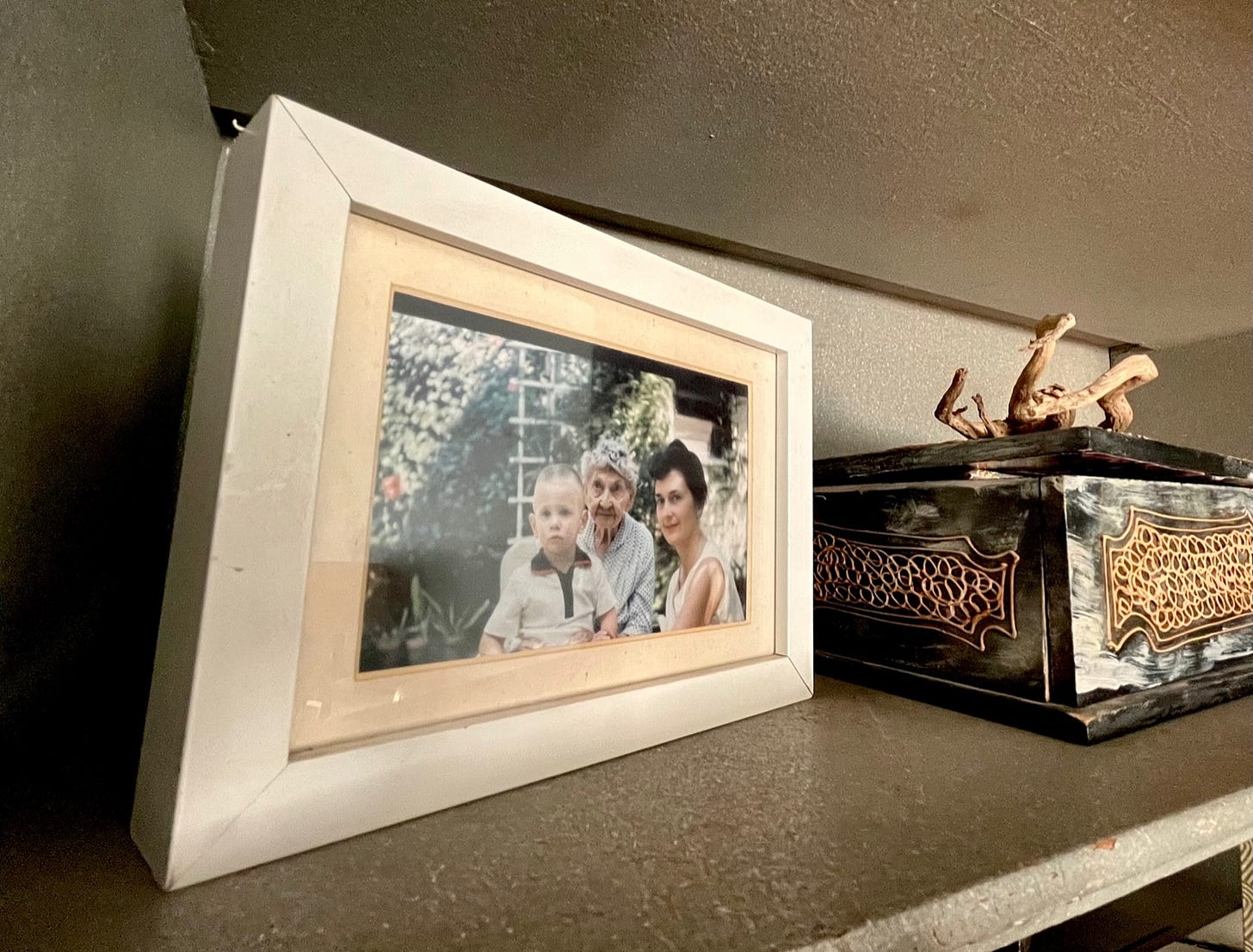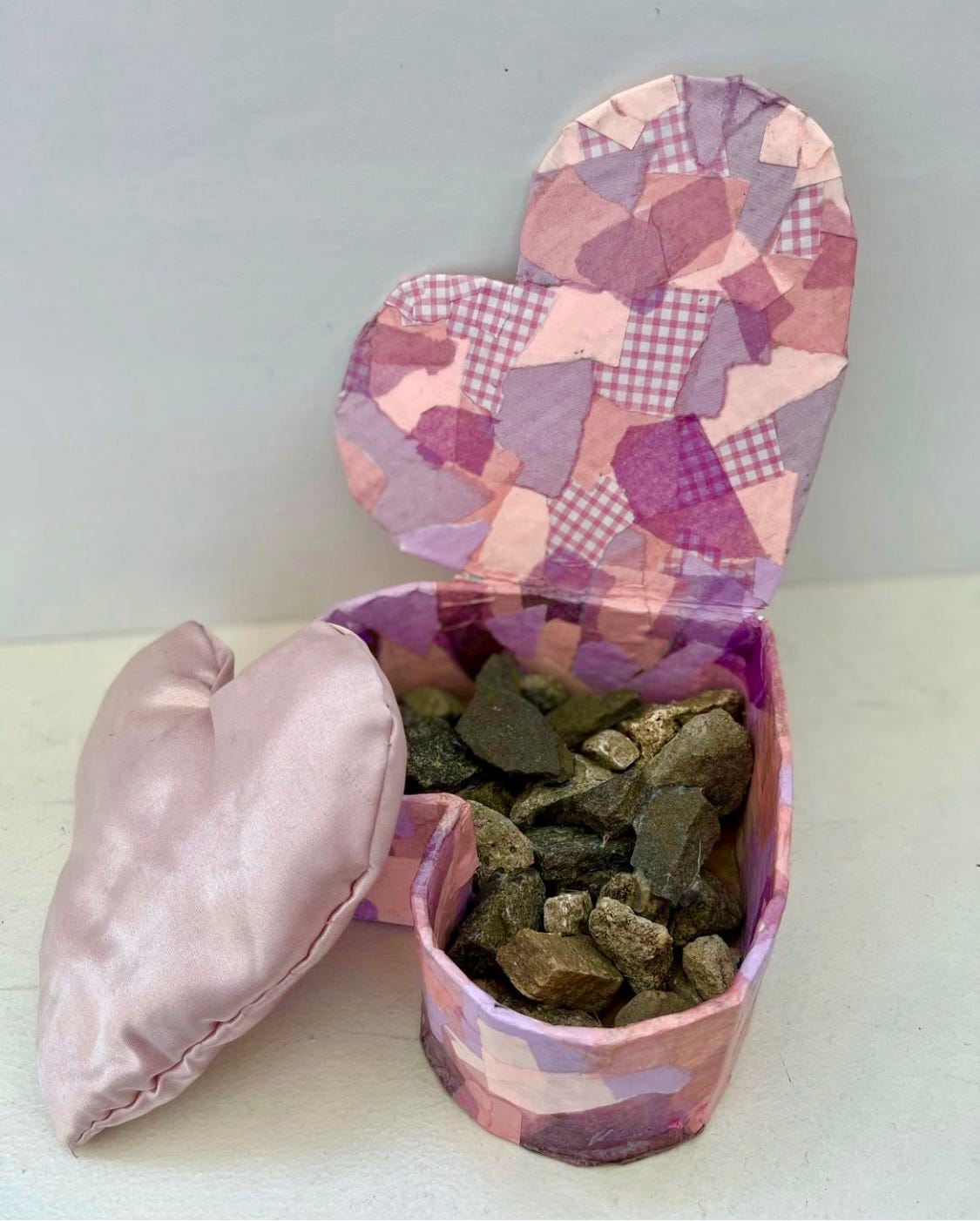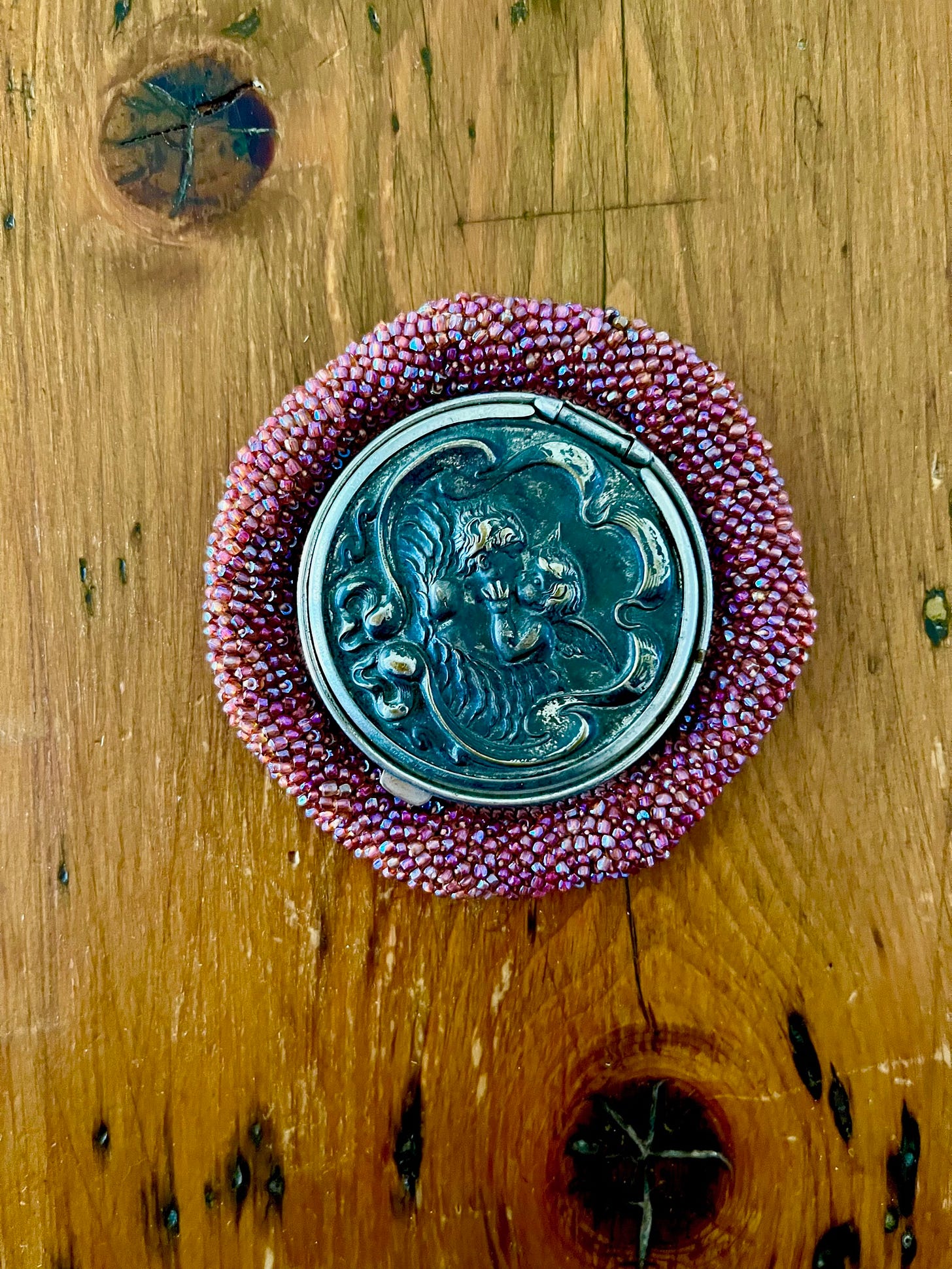Finding a safe place for the mind's loose change
Our Complicated Mother's Day ended in the ER. A rediscovered treasure from my grandmother offered surprising solace.

Last week I wrote about what I thought were most of the possible complications of Complicated Mother's Day – and then my child fell and hit his head hard in the backyard. So while the day began with sweet-crazy kid-made cards and chocolate-chip pancakes, it ended in a haze of gauze and stitches. A different kind of Complicated Mother’s Day.
As a child, I had my own shin stitched up at age seven or so, after tripping over rusting barbed wire near my childhood home in rural Utah. The next year, I stayed overnight in the hospital, after I flipped over my bike handlebars on a potholed hill and fractured my skull. As an adult with a chronic illness (I have endometriosis), I haven’t fared much better: I’ve been in and out of more hospitals than I can count. Yet my husband and I were still surprised by our own shock on Sunday afternoon, as we watched our own little one now suffering amid the din of the Children’s Hospital ER.
As a child, I sometimes fell. My child will fall again. In the times in between, we try our best to get back up. Sometimes we can, and sometimes we can’t. These truths are part of the indestructible currency of our fragile lives. Life just keeps handing them to me, like rusting pennies. It’s not always clear how or if I’ll use them. For now, the memories of this complicated Mother’s Day, the harsh colors and sounds of it, are still jingling around like loose change around the bottom of my mind.
After fresh trauma, I’ve learned this year, the mind will often try to shake these things into this or that maladaptive schema — mental boxes with labels like “Who Is to Blame” or “Why These Things Always Happen to Me” – in order to try to silence the rattling. Ultimately, though, I’ve learned to resist this urge, these less-than-helpful boxes. To wait to make meaning until we’re closer to what reporter Ashley Locke and I recently referred to as the middle distance – the place where the story still packs a punch, but also offers some useful and compassionate perspective.
So for now, I’d like to share a story about how I’m learning to better care for myself in the immediate aftermath of a bad thing. It comes courtesy of a new EMDR practitioner I've started seeing, who has helped me to craft new ways of holding the odds and ends of my still-unready stories. To make a mental version of the notebook in which Joan Didion used to keep her “bits of the mind’s string too short to use, an indiscriminate and erratic assemblage with meaning only for its maker” — one I can take with me anywhere I go.
For those who don't know about EMDR (which stands for eye movement desensitization and reprocessing), it's a therapeutic tool used for people who have been diagnosed with PTSD like me, one that has been shown to ease the symptoms of trauma. It can involve looking from right to left (hence the “eye movement” part of EMDR) or it can involve tapping parts of the body. While it sounds simple, it can help people to better work with many kinds of complex memories and emotions.
(Aside: if you’re curious to hear more about the particulars of EMDR, and what it’s like to have a session, you may enjoy reading What My Bones Know by Stephanie Foo. Hers may have been my favorite book of last year, and one I'd like to write more about at length when I have more of my wits about me.)

The Container Exercise
The Container Exercise is part of the pre-work before beginning EMDR. Why pre-work? EMDR involves calling up a troubling event or image in a supported space. Some of the things that arise will be able to be processed in that session, but some the brain might not be ready to work with yet, like the sensations of last Sunday for me. The last thing you want to do is shake a bunch of thought-pennies out onto the floor, without any new place to put them.
I think the fear of this keeps many people from seeking out forms of therapy in the first place – the idea that they will be opened up, without anywhere to put the things that they’ve kept pushed to the bottom of the mind for so long. I can empathize with this. As someone who struggles to stay asleep after challenging or busy days, I often wake up at 3am with a brain that is furious that piles of emotional clutter have been left all over its nice clean floors. And it will not be satisfied with “I’ll take care of it in the morning.”
However, most good therapists will mitigate this any way that they can. The Container Exercise is one such way. It's guiding the person on the couch to create a mental vessel inside of themselves that is protected, private, and importantly, lidded–for all that is still liminal and unready in them. It helps to create that “clean floors” feeling in the mind at the end of the day, even after you’re off the therapist’s couch.
This is not the first time I’ve been offered the Container Exercise, for that reason—to help with cPTSD-related insomnia. In the past, however, it did not work for me, because my previous EMDR practitioner was actually too helpful in prescribing the kind of container I should use. Instead of inviting me to mentally craft one of my own, she explicitly said, “Imagine a shoe box, and imagine the shoe box sliding under your bed. That’s where you can leave your unsolved problems for the night.”
That imagery didn't work for me. As a neurodivergent person who has to see my materials arrayed in front of me visually to feel prepared and organized, I didn’t like the notion that I couldn’t see where my most troubling thoughts were kept. Having important items stashed too deeply away, or in dark cabinets or refrigerators or basements that are already too crowded with objects, is unsettling for me. I imagined them beating and thrumming like something out of Poe’s “Telltale Heart.” Not a relaxing thought at 3am.
Furthermore, the notion of a shoebox didn’t feel worthy of holding the kinds of things I often struggle to set down. Teaching during the pandemic, for example, I would find myself still carrying thoughts of suffering children or colleagues I deeply loved inside of my heart, even after I walked away from my desk. And now, there is nothing more important to me than my child — cliche but true. A petty argument with someone I don’t particularly like? Sure, that can go in a shoebox. But the most vulnerable and precious people to me? That makes me hesitate.
Yet when I hesitate to set things down, I end up holding more than I can reasonably carry—and eventually collapsing under the weight. That isn’t ultimately helpful for the people I’m hoping to help.
So it was nice, small pun intended, to open this container exercise back up again with this particular practitioner. Because this time, it became my job, not hers, to imagine other holding spaces besides a shoebox. New places where I could put things like the image of my child when he first looked up at me, his eyes filled with fear after he cut his head open, or what it was like to see the ER doctor with the bouncing ponytail sew it awkwardly back up.
What kind of a container could that be, though?

Smaller than a bread box, better than a shoe box
As it happens, I collect all kinds of containers: an ornate box that my brother made in an art class before he died, a Japanese donabe pot I picked up with a dear friend in a Catskills thrift store while we discussed our latest IVF struggles, an array of iridescent clay vases that my sweet friend Jessie makes and brings to my house every time she visits (like this beauty here, which now enjoys pride of place on my kitchen counter).
I inherited this container-collecting habit from my Grandma Marion. She raised me, in large part, and I honor her on Mother’s Day as well. She cared for me daily, from when my mother went back to work at eight weeks postpartum until I was almost ready for kindergarten, and then at least weekly after that. She took me to the library and to my first Shakespeare play, igniting my love for reading and writing. In her garden, I learned all the names of the flowers and birds. There is so much of her mothering of me that comes through in my own mothering, and in my writing here. She passed away when I was in college, and her containers and old photo-memories have long anchored my ancestor altar (above).
In particular, I remembered a beaded coin purse of hers I had inherited, the size and color of a beating heart, now locked in my bedroom safe. It had a pewter lid that clicked open and closed with a satisfying snap. In her home, it was propped up on its own dedicated small stand, like a painting. For years it sat against a wall papered with maps, in a room where I often slept when I stayed over.
I unlocked the safe and held the coin purse in my hand, then placed my other hand over it. It still looked like something out of a fairytale or a fantasy novel—something in which a magical coin might be kept for a time, until it was ready to be used.
This coin purse might do for EMDR, I thought. It looked delicate enough to hold something fragile, like the face of my four-year-old in a moment of fear — but also imbued with my grandmother’s specific kind of feminine power. One that she flexed quietly, in her intent way of listening, but also at higher pitches, when she was called upon for protection.
“Oh, come on,” she'd say, her melodic Midwestern drawl rolling down the vocal register into a kind of low growl, her jaw tightening, as she fixed the same brown eyes I have now on whomever was aggravating her or her granddaughter with an unwavering stare. Man, woman, or child: it didn’t matter. That would be that. The matter, like the coin purse, would be snapped closed for now.
Ultimately, this was the image I chose for my EMDR exercise this week. A beaded, beating heart — one with a lid that can open and close as I need it to during those sleepless nights that follow a fresh trauma. As fragile and strong as the shell of an oyster, as it filters clean its share of the dark and endless ocean.
Where the treasure was buried
I'm so grateful that this sacred object, just like the ones in the fairy tales we used to read together, was not hidden away on some faraway mountain where all of the fully-healed people live once they’ve read all the right books. Or only something I could obtain from the hands of a stranger I paid to give me all the answers.
It was inside of me the whole time, inside of my room, right next to my own beating heart.
It is important to acknowledge that I still needed somebody to guide me to find it. The heroines in those fairytales often did too. That is the role on offer to every well elder in our lives, whether they are living or overseeing our affairs from our altars. Not to give us the magical makeover we could never manage for ourselves, or to poof our problems away with a magic wand—but to point to the worthy person we have already become, by dint of putting our own necks on the line for someone else in need. To remind us: “You could always go home. You’ve had this power the whole time. You just needed to be ready to use it.”
That permission to seek the treasure I needed in the home of my own memories, to locate the sacred container for the loose coins that still rattle around in my mind’s darker recesses, was exactly the Mother's Day gift I needed this week. Though my therapist helped, and I did the work, I cannot help but think that this gift truly came from my grandmother.

NOTES
- had a great piece this week in BAD AT KEEPING SECRETS about the complexity of writing about our children when we write about our mothering….
…and so did
, who interviewed about her book, “The Leaving Season.”
If you are interested in learning more about the Container Exercise, I found this link from Resilient Life Therapy (MN) helpful. Like my therapist, they invite people to envision their own containers, often with sweet and surprising results: “Some people have imagined armoires, unique wooden containers with small and big drawers, tool boxes, mason jars, rubber-maids, cookie jars, etc. There is no right or wrong.”
If you feel called to, you can also close your eyes and let this guided audio track support you in calling up your own container.
If you’d like to try making your own container, you may be inspired by the work of my eighth graders last year, guided by my colleague Kendra and inspired by the work of artist Theda Sandiford, to create vessels to contain their feelings about heading to high school. (I am the proud steward of the heart-shaped box of rocks featured above and in this Instagram post—because as a teacher, our privilege and burden is often to hold the heavy stones of emotion our students cannot leave anywhere else.)
This week, I’m also thinking about the legacy our mothers and elders leave behind more than ever, because in my professional community, we are mourning the loss of NYC educator and mother Jeannine King. Jeannine mentored the boss who kept me in the teaching profession when I was struggling to stay, and she did the same for the next one, who quietly arranged for my bereavement leave after late pregnancy loss last year, when I needed to be gone. Jeannine has taught many teachers the anti-bias, antiracist values that infuse my own practice and writing, like the ones I express here. She was an influential voice in the life of Kendra as well, the colleague who guided the container creation project depicted above. Jeannine was truly a Mother Tree. If you are so inclined, please donate to the Gofundme to support her son’s college fund, so that he can carry on the legacy of education she leaves behind: https://gofund.me/72702c62





Sorry about the emergency room visit. I love this and I love the coin purse you chose: “These truths are part of the indestructible currency of our fragile lives. Life just keeps handing them to me, like rusting pennies. It’s not always clear how or if I’ll use them.”
I find it endlessly fascinating how our brains work on this stuff. This week my therapist gave me a little plush toy to help with grounding when I’m having a ptsd response. I’ve tried loads of grounding exercises, but something about squeezing this silly little toy really helps. It’s both hilarious and hopeful that a simple tweak to a tool -- like a coin purse or a plush toy -- can help something so profound click in our minds.
I found myself wanting to hear a guided meditation on creating that safe container. Guess I’ll have to write that one myself!